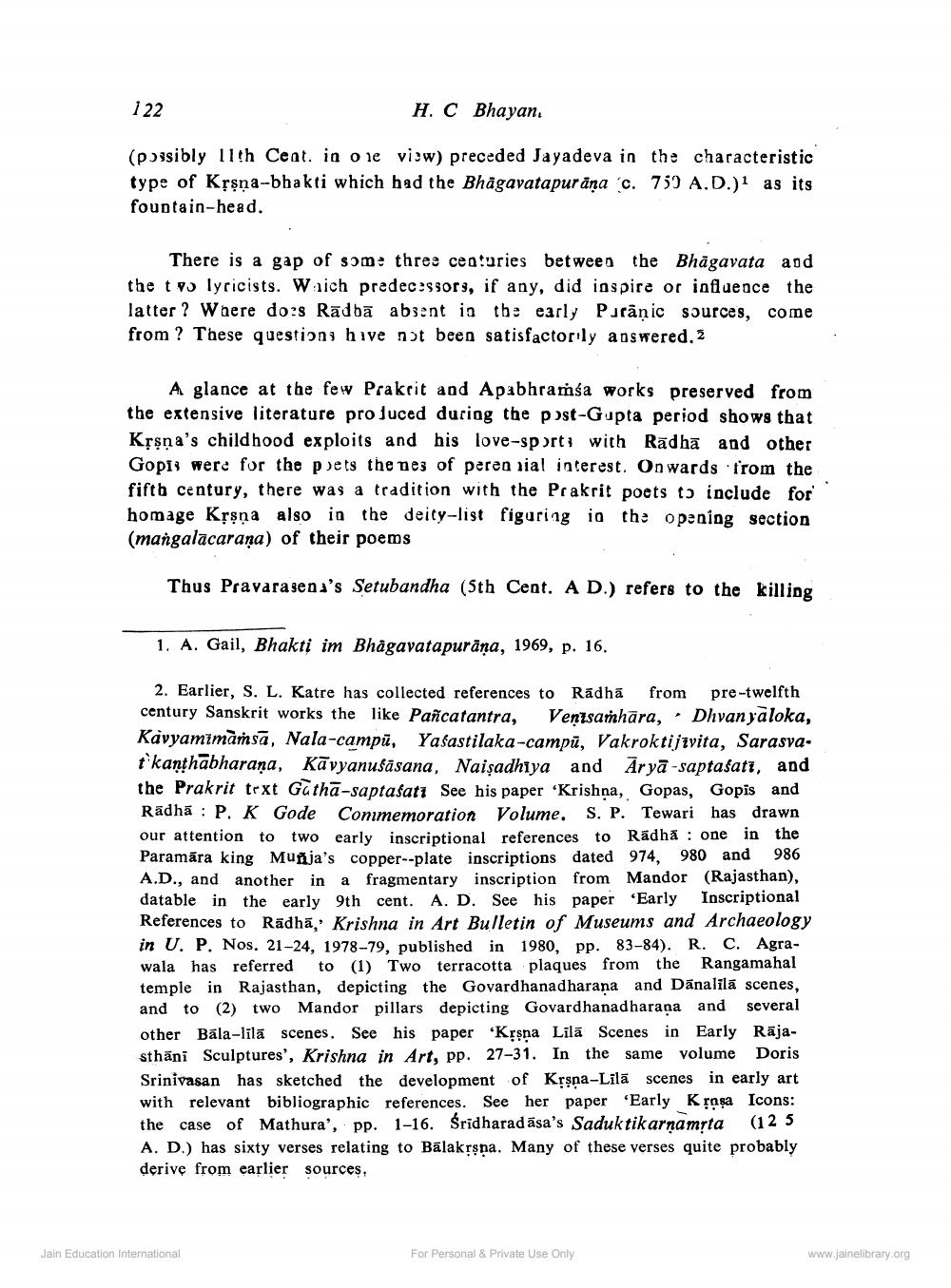________________
122
H. C Bhayan.
(possibly 11th Cent. in one viow) preceded Jayadeva in the characteristic type of Krşna-bhakti which had the Bhagavatapur āņa (c. 750 A.D.)" as its fountain-head.
There is a gap of som: three centuries between the Bhagavata aod the tv lyricists. Waich predecessors, if any, did inspire or influence the latter? Where dois Rādbā absent in the early Picānic sources, come from ? These questions have not been satisfactorily answered. 2
A glance at the few Prakrit and Apabhramsa works preserved from the extensive literature produced during the post-Gupta period shows that Krsna's childhood exploits and his love-sports with Rādha and other Gopis were for the poets the ne of perensial interest. Onwards from the fifth century, there was a tradition with the Prakrit poets to include for homage Krsna also in the deity-list figuring in the opening section (mangalacarana) of their poems
Thus Pravarasena's Setubandha (5th Cent. A D.) refers to the killing
1. A. Gail, Bhakti im Bhagavatapurāna, 1969, p. 16.
2. Earlier, S. L. Katre has collected references to Rādhā from pre-twelfth century Sanskrit works the like Pañcatantra, Venisamhāra, Dhvan yaloka, Kavyamimamsā, Nala-campū, Yasastilaka-campū, Vakroktijivita, Sarasva. t'kanthabharana, Kā vyanusāsana, Naişadhiya and Aryā -saptasatz, and the Prakrit text Gathā-saptašati See his paper ‘Krishṇa, Gopas, Gopis and Radha : P. K Gode Commemoration Volume. S. P. Tewari has drawn our attention to two early inscriptional references to Radha : one in the Paramāra king Muñija's copper--plate inscriptions dated 974, 980 and 986 A.D., and another in a fragmentary inscription from Mandor (Rajasthan), datable in the early 9th cent. A. D. See his paper 'Early Inscriptional References to Rādhā, Krishna in Art Bulletin of Museums and Archaeology in U. P. Nos. 21-24. 1978-79, published in 1980, pp. 83-84). R. C. Agrawala has referred to (1) Two terracotta plaques from the Rangamahal temple in Rajasthan, depicting the Govardhanadharana and Dānalilā scenes. and to (2) two Mandor pillars depicting Govardhanadharana and several other Bāla-lilā scenes. See his paper "Krsna Lilā Scenes in Early Rājasthāni Sculptures', Krishna in Art, pp. 27-31. In the same volume Doris Srinivasan has sketched the development of Krşņa-Lilā scenes in early art with relevant bibliographic references. See her paper 'Early Krașa Icons: the case of Mathura', pp. 1-16. Sridharadāsa's Saduk tik arnamta (12 5 A. D.) has sixty verses relating to Balakrşna. Many of these verses quite probably derive from earlier sources,
Jain Education International
For Personal & Private Use Only
www.jainelibrary.org




